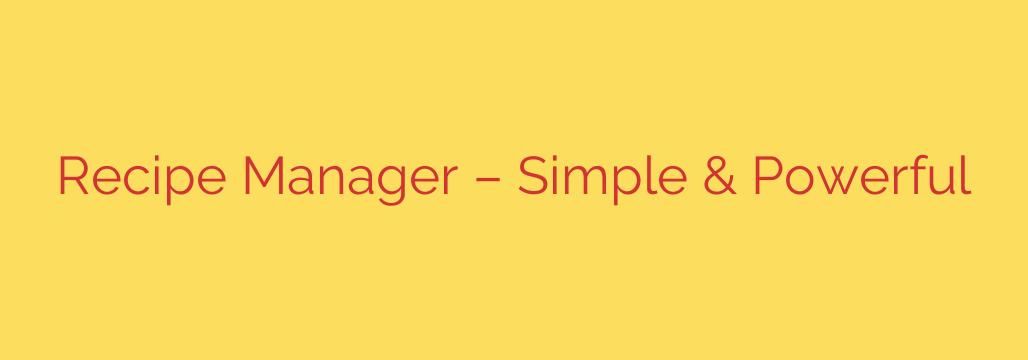
The Ultimate Guide to Choosing a Simple & Powerful Recipe Manager
In today’s busy world, managing your favorite recipes can feel like a chore. You might have recipes bookmarked on your browser, saved on Pinterest, jotted down on notecards, and scattered across a dozen different cookbooks. Finding that one perfect chicken dish you made six months ago can turn into a frustrating scavenger hunt. Fortunately, there’s a modern solution: a digital recipe manager.
A powerful recipe manager is more than just a place to store recipes; it’s a central hub for your entire culinary life. It can streamline your meal planning, simplify your grocery shopping, and preserve your most cherished family dishes for generations to come. Let’s explore how these tools can transform your kitchen.
Centralize Your Entire Recipe Collection
The single biggest advantage of a recipe manager is bringing order to chaos. Instead of searching in multiple places, you have one unified, digital cookbook.
- Import from anywhere: Modern recipe managers allow you to effortlessly clip and save recipes from any website with a single click. The software intelligently pulls the ingredients, instructions, and photos, formatting them into a clean, easy-to-read layout.
- Digitize family classics: You can manually enter those handwritten recipes from your grandmother’s card box. Scan or take a photo of the original card and attach it to the digital version to preserve the memory.
- Consolidate cookbooks: Take your favorite recipes from physical cookbooks and add them to your digital collection, so you only need to search in one place.
By creating a single source of truth for all your culinary inspiration, you’ll spend less time searching and more time cooking.
Unlock Powerful Search and Organization
Have you ever had a few ingredients in the fridge and wondered what you could make? A digital recipe organizer makes this easy. Unlike a physical cookbook, a digital manager offers robust search and filtering capabilities.
You can instantly find recipes based on:
- Ingredients (e.g., “chicken,” “broccoli,” “lemon”)
- Cuisine (e.g., “Italian,” “Mexican,” “Thai”)
- Dietary restrictions (e.g., “gluten-free,” “vegetarian,” “low-carb”)
- Cooking time (e.g., “under 30 minutes”)
- Custom tags (e.g., “weeknight favorite,” “holiday,” “kid-friendly”)
This powerful search function means you can always find the perfect recipe for any occasion, using the ingredients you already have on hand. This helps reduce food waste and inspires creativity in the kitchen.
Streamline Meal Planning and Grocery Shopping
The best recipe managers integrate seamlessly with your weekly planning. This is where they truly become an indispensable tool.
- Build a Meal Plan: Drag and drop recipes onto a weekly or monthly calendar to plan your meals in advance. This takes the daily stress out of deciding “what’s for dinner?”
- Generate Automatic Grocery Lists: Once your meal plan is set, the system can automatically generate a consolidated shopping list. It combines all the necessary ingredients, categorizes them by aisle (e.g., produce, dairy, pantry), and even lets you check off items as you shop.
- Adjust Serving Sizes: Need to cook for two people one night and six the next? A quality recipe manager allows you to scale ingredients up or down with a single click, saving you from complicated math and potential cooking errors.
Actionable Tips for Choosing the Right Recipe Manager
Not all recipe organizers are created equal. When selecting a tool, look for these key features to ensure it meets your needs:
- Ease of Use: The interface should be clean, intuitive, and easy to navigate. A complicated system will only add to your frustration.
- Cross-Device Syncing: Your recipes should be accessible on all your devices—phone, tablet, and computer. This allows you to plan meals on your laptop and pull up the recipe on your phone in the kitchen.
- Robust Importing Tool: Test how well it clips recipes from your favorite food blogs and websites. It should be fast, accurate, and require minimal manual editing.
- Offline Access: Ensure you can access your recipes even without an internet connection. This is crucial for when you’re in the grocery store with poor reception or cooking in a location with spotty Wi-Fi.
- Data Backup and Export: Your recipe collection is valuable. Choose a service that allows you to back up your data or export it in a common format. This protects you in case the service ever shuts down or you decide to switch platforms.
By taking control of your recipes with a simple yet powerful digital manager, you’re not just getting organized—you’re investing in a more efficient, creative, and enjoyable cooking experience.
Source: https://www.linuxlinks.com/recipya-simple-powerful-recipe-manager/








